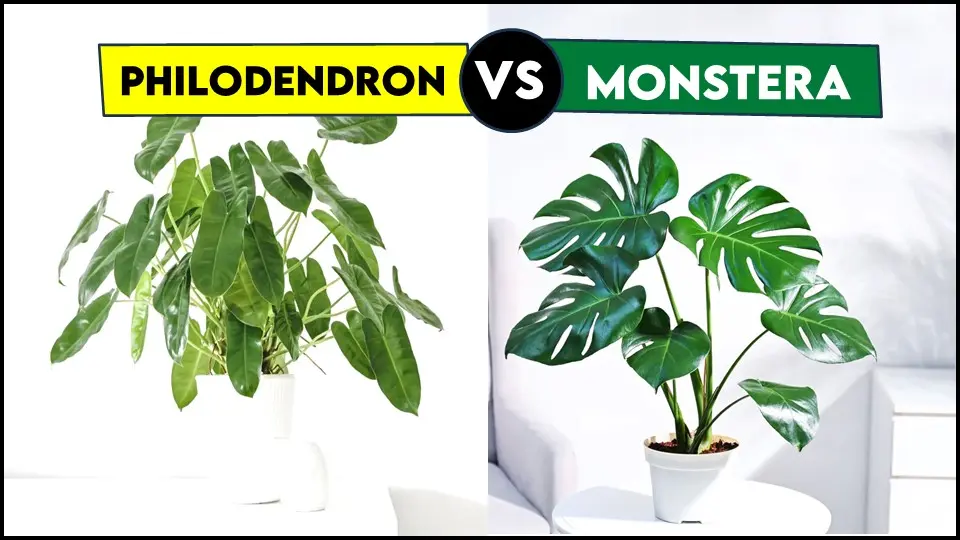Philodendron vs Monstera: 2 Perfect Plants of Choice
To set amid tropical rainforest in our home or workplaces, we often end up getting plants with huge leaves which often have fenestrations or slits. But in the search for such plants, people often confuse the species and end up getting unexpected results. To save yourself from such mishappenings, scroll down to find the key differences and lucrative properties of two such most popular plants, Philodendron and Monstera.
This comparison of Philodendron vs Monstera will not only help you to identify the plants, but the facts unknown to you about these green ornamentals will also be unlocked here, in this article. Belonging from the same family Arum, they have only a few morphological differences, which are hard to identify by a layman. Worry not, because you are about to get a detail on everything you need to know before buying one of these.
But, let us first give you a brief description of these two:-
What is Philodendron?
Philodendrons are native to tropical forests in South America, these are known to be widely spread epiphytes, and hence, it is adapted to low sunlight and shade, making them one of the best plants to grow indoors. The survival rate and adaptability of this plant are remarkable, hence, there are more than 450 plant species of philodendrons around the world. Some of these grow only up to six inches and some are as tall as up to 72 inches. Usually, the climbing type Philodendrons are the smaller ones that are also a perfect fit for table decor, and the giants are the ones with upright growth.
The most common and widely domesticated species among these is Philodendron hederaceum, a variety of oxycardium, which has beautiful heart-shaped and leathery-green leaves. The heart-shaped leaves are deeply cut and add a wavy element to the plant. Some other species with different colour gradients are also available in nature.
Unlike other plants, it follows a rather unusual type of survival phenomenon. Instead of growing towards the sun, it grows towards the place where it can get ample amounts of nutrients. Just like the humans, it wanders around its host tree to find comfort in living. While growing in the forest it grows new stems to move forward and the older stem dies. You won’t get to see it doing this incredible thing, because you came here intending to grow it in a pot with nutrient-rich soil.
Philodendrons are also known to have little water needs, just don’t overdo it and use a pot with appropriate drainage. Never let them experience frost, just provide them with a warm and humid environment. As Philodendrons are also one of the fastest-growing houseplants, which may need pruning during spring or Summer. You can also start propagating them via stem cuttings. This is one of the fastest methods of multiplying these species.
Uses of Philodendron:
- Philodendrons are considered as an excellent Houseplant.
- They hold a great ornamental value among gardners and designers.
- It is also known that certain part of this plant can cure skin diseases.
- And for the obvious reason of having extraordinary air-purifying capabilities.
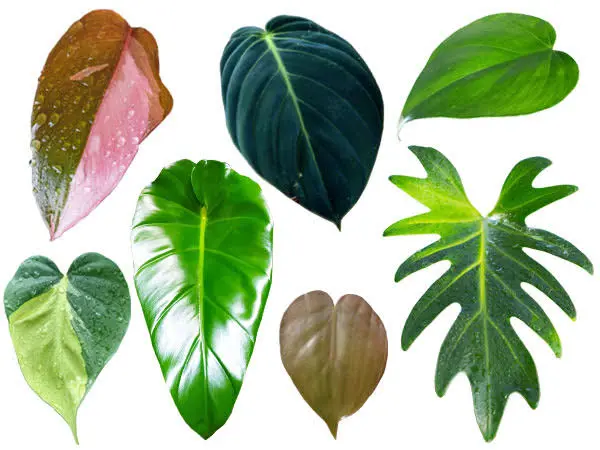
What is Monstera?
These are also native to the tropical rainforest of South America, and hence, they have been developed under similar environmental conditions as that of the Philodendron. Monsteras are named after its unusual huge heart-shaped leaves with irregular fenestrations. Although, it is one of the adaptive plant features against abrupt weather conditions. Its leathery leaves can’t go without being noticed.
The fenestration on its leaves is the indicator of the life of this plant. A small and underdeveloped plant doesn’t have fenestration, which is a major reason for confusing it with other plants. As the age of Monstera increases, the fenestrations also grow further in the leaves reaching from midrib to leaf margin.
There are about more than forty different species of Monsteras known around the world. But let’s be honest, there are no major differences among these species except for colour variations and leaf size. And many of these are developed after human intervention in their reproduction. The Monstera can reach up to twenty metres in outdoor conditions and only up to 2-3 m in indoor conditions, with minimum sunlight and water requirements.
The most common species among these is Monstera deliciosa, it is also known for bearing one of the tastiest fruits in the world, which is cylindrical and tastes much better when fully ripened. It contains many nutrients that are good for our health.
Sadly, it is hard to develop a fruit in this plant outside its native region, even flowering is rare in such states. But be careful with the leaves, unlike its fruit the leaves are toxic to pets and children. On the contrary, the roots are used for making baskets and treating snake bites.
Uses of Monstera:
- As a houseplant.
- It can fill in large spaces.
- It produces Tasty and nutrient-rich fruits.
- It acts as an air purifier.
- It is the best choice to create an indoor jungle.
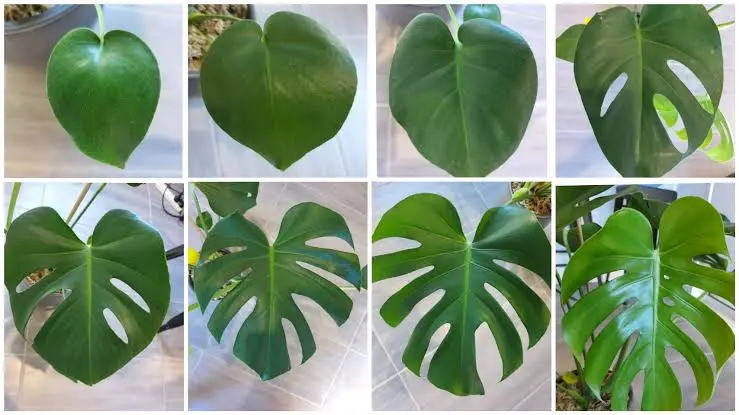
ALSO READ: How to Propagate Mini Monstera
Common features of Philodendron and Monstera
| Features and Requirements | Monstera | Philodendron |
| Common Name | Swiss Cheese Plant, Fruit Salad Plant, Window Plant. | Philodendron, Sweet-heart plant. |
| Scientific Name | Monstera sp. | Philodendron sp. |
| Family | Araceae | Araceae |
| Origin | Southern Mexico & Central America | Central America, South America |
| Height | 2-20 m | 0.1-1.8 m |
| Sunlight | Semi-Shade/ Full Shade | Semi-Shade/ Full Shade |
| Temperature | 18°C- 29°C | 15°C- 24°C |
| Soil | Well-drained & Slightly Acidic | Well-drained & Slightly Acidic |
| Hardiness Zone | 10-12 | 9-11 |
| Propagation | Stem Cutting | Stem Cutting |
| Common Species | Adanson’s monstera Monstera deliciosa Monstera obliqua Monstera siltepecana, etc | Philodendron hederaceum Philodendron Tortum Philodendron McColley’s Finale Philodendron Rojo Congo. |
ALSO READ: How to Care for Elephant Bush
Philodendron VS Monstera: Major Differences
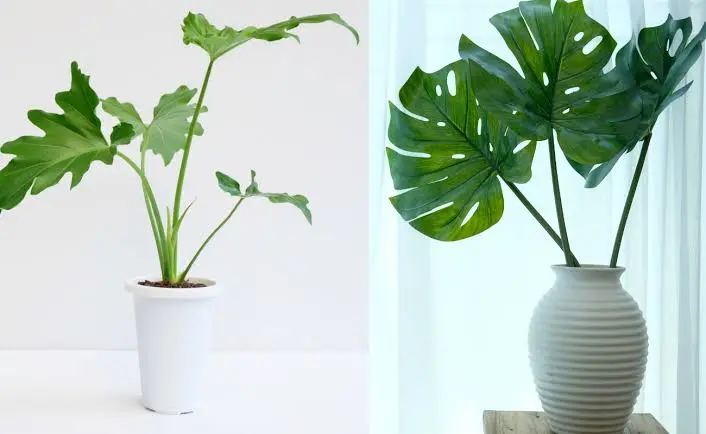
Fenestrations: One major difference between these two is the presence of fenestrations in monstera which is absent in philodendron. However, it is difficult to look for fenestration in the early stages of the plant.
Climbing Habit: Another, most important difference is their climbing habit, as many species of philodendron are known to have this ability, monsters are always grown upright.
Height: Although Monsteras have a slower growing habit, they are bigger and taller than any species of Philodendron.
Leaf Sheaths: Young leaves of philodendron have protective sheaths of cataphyll that slowly turn brown and fall on maturity, this sheath is completely absent in monstera. Monstera seems to have curled leaves when young.
Water and Nutrient: Philodendrons are sensitive to water and nutrient requirements as compared to Monstera.
Fruits: As we also know about the delicious fruit of Monstera, the Philodendron gives no such benefits. Both of these also bear aerial roots but only the philodendrons use them to climb upon the trees.
| Features | Philodendron | Monstera |
| Fenestration | Absent | Present |
| Height | 0.1-1.8 m | 2-20 m |
| Climbing habit | Present in some | Absent |
| Growth | Relatively High | Slow |
| Fruit | Absent | Present |
| Water and Nutrient sensitivity | High | Low |
| Leaf Sheath | Present | Absent |
| Leaf Texture | A little rough and bulge outward | Smooth |
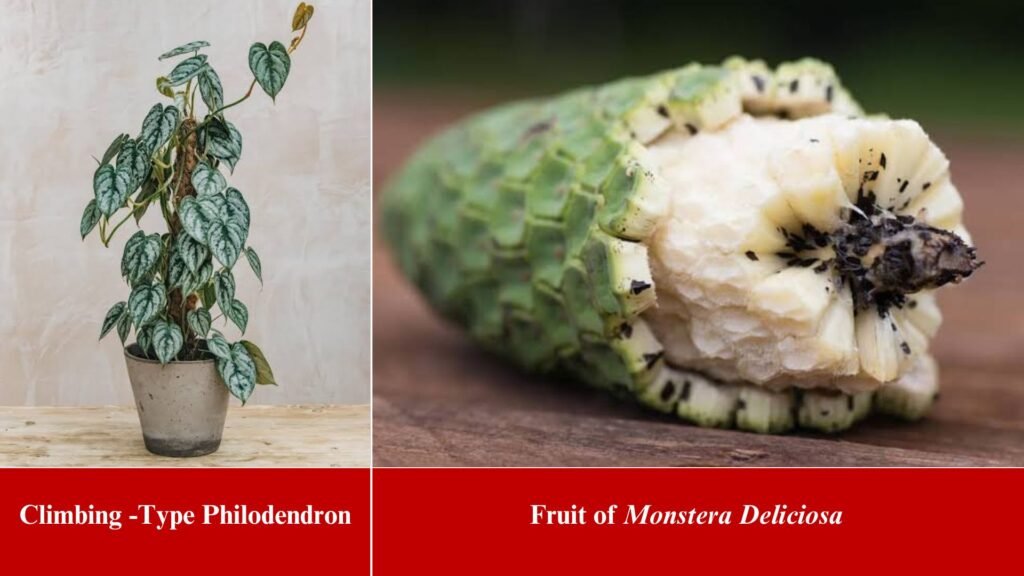
Which One is Best For Me? Philodendron or Monstera
It’s hard to tell what is best for you, without knowing what you want and where you live, so let me help you if you have these questions.
| Questions | Philodendron | Monstera |
| Will it cover huge spaces in my home? | No | Yes |
| Can I use it as a table decor? | Yes | No |
| Will it climb on my other plants or Railings? | Yes | No |
| Is it Eye-catching? | Yes | Yes |
| Can it survive with little care? | Probably not | Yes |
| Can it tolerate low temperatures? | No | No |
Conclusion
The things that look alike are not always the same, but if you know how the things were created or developed, you can easily distinguish them from each other. The same goes for plants. Philodendrons and Monsteras are easily available in nurseries around the world. Yet people can’t tell the difference. But there is no shame in learning and practising.
I hope this article ‘ Philodendron VS Monstera’ would have been a part of your learning and a little helpful with your questions & confusion. If you are one of those who accidentally bought the wrong plant, I suggest that you cherish it. A plant is never a waste, it will surely fill your space with its green magic, but never stop learning about it and take care of its needs. After all, whatever you own becomes your responsibility.
ALSO READ: Cinnamon Girl Distylium Care

